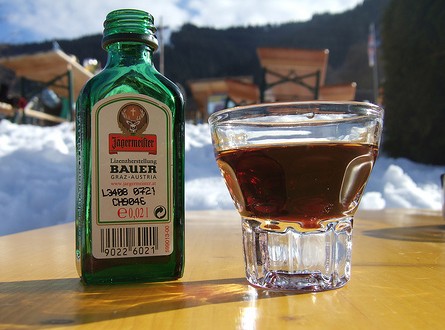Jagermeister Does Not Contain Deer Blood
October 15, 2010 at 3:00 am Chad Upton 8 comments
By Chad Upton | Editor
The word “Jägermeister” was first used in 1934 as the name for senior gamekeepers in the German civil service.
In English, Jägermeister translates to “hunt-master,” but most people know it better as a bitter sweet liqueur.
It was developed by Curt Mast in 1935 as an after meal digestif (to aid digestion). It’s named after the German hunt master and carries a stag on the front of the bottle because the inventor was an avid hunter. The glowing cross above the deer’s head pays homage to the patron saints of hunters, Saint Hubertus (Hubert) and Saint Eustace.
A common rumor is that Jagermeister contains deer or elk blood, although that has been debunked.
There are also rumors that it was originally used as a cough syrup. Although it might taste like it, Jägermeister was not marketed as a cough syrup, but it was introduced during the era of patent medicines and it is and has always been a digestif — a liqueur made from bitter herbs, believed to aid digestion.
 Despite the fact that it was not designed to be medicine, alcohol was often used as a medicine in those times, even given to babies and young children. Frankly, that hasn’t changed all that much, the cough syrup Nyquil still contains alcohol.
Despite the fact that it was not designed to be medicine, alcohol was often used as a medicine in those times, even given to babies and young children. Frankly, that hasn’t changed all that much, the cough syrup Nyquil still contains alcohol.
Often referred to as “Jager” it is commonly mixed with RedBull to create a “Jager Bomb” (or “Jager Blaster” in some places).
Jägermeister is 35% alcohol by volume (70 proof). It contains 56 herbs, roots, fruits and a variety of spices including: anise, saffron, citrus peel, licorice, ginger, ginseng, juniper berries and even poppy seeds. These ingredients are pressed and steeped in a water/alcohol mixture for a few days before being filtered. Then it gets similar treatment to fine wines — it is aged in Oak barrels to further enhance the flavor (for about a year).
Broken Secrets
Subscribe on: Facebook | Twitter | Email | Kindle
Photo: Ehsan Roudiani (cc)
Sources: The Bitter Truth, Everyday Drinkers, Snopes, Wikipedia (Jägermeister),
Entry filed under: Food and Drink. Tags: alcohol, blood, booze, deer, elk, jagermeister, liqueur, spirit.
8 Comments Add your own
Leave a comment
Trackback this post | Subscribe to the comments via RSS Feed






1. Nikola Malesevic | October 15, 2010 at 3:29 am
Nikola Malesevic | October 15, 2010 at 3:29 am
Thank you so much for sharing this information, Chad!
2. Daisy | October 15, 2010 at 9:42 pm
Daisy | October 15, 2010 at 9:42 pm
Dude, Jager is delicious! I had never heard about there being blood, but it’s nice to know it’s got all that good stuff in it!
3. Cole | October 16, 2010 at 1:17 am
Cole | October 16, 2010 at 1:17 am
Where is this a common rumour?
4. effablethoughts | September 25, 2015 at 4:29 pm
effablethoughts | September 25, 2015 at 4:29 pm
East coast Canada, apparently. This claim just came up in the living room/ jam room.
5. krautter | October 16, 2010 at 3:55 pm
krautter | October 16, 2010 at 3:55 pm
My last name is Krautter, which means herb-gatherer in German, so I got a kick out of seeing jagermeister that says Krauter-Liqueur on it.
http://en.wikipedia.org/wiki/Kräuterlikör
http://www.flickr.com/photos/56635145@N00/3014454644/
6. john916fndc | April 8, 2012 at 9:21 pm
john916fndc | April 8, 2012 at 9:21 pm
Jagermeister does indeed resemble cough syrup, but it is a completely unique cordial. Nothing else tastes like it, with the possible exception of Barenjager. I remember first hearing about it when reading an article on Metallica back in the Master of Puppets days, saying they compared it to “Liquid Valium”. These days, I would not consider my home bar stocked at all unless there is a bottle of Jager at the ready.
7. 24 Hours Of @UberFacts: So Many Lies, So Little Time | Gizmodo Australia | March 13, 2014 at 5:01 pm
[…] Jagermeister was first concocted around 1935 as a digestif. Some people think it tastes like cough medicine, which is what keeps this inaccurate fun fact […]
8. 24 Hours Of @UberFacts: So Many Lies, So Little Time | Online-Bookshop.co.uk | March 14, 2014 at 4:16 am
[…] Jagermeister was first concocted around 1935 as a digestif. Some people think it tastes like cough medicine, which is what keeps this inaccurate fun fact […]